AMD Zen 3 Ryzen Deep Dive Review: 5950X, 5900X, 5800X and 5600X Tested
by Dr. Ian Cutress on November 5, 2020 9:01 AM ESTCPU Tests: Simulation
Simulation and Science have a lot of overlap in the benchmarking world, however for this distinction we’re separating into two segments mostly based on the utility of the resulting data. The benchmarks that fall under Science have a distinct use for the data they output – in our Simulation section, these act more like synthetics but at some level are still trying to simulate a given environment.
DigiCortex v1.35: link
DigiCortex is a pet project for the visualization of neuron and synapse activity in the brain. The software comes with a variety of benchmark modes, and we take the small benchmark which runs a 32k neuron/1.8B synapse simulation, similar to a small slug.
The results on the output are given as a fraction of whether the system can simulate in real-time, so anything above a value of one is suitable for real-time work. The benchmark offers a 'no firing synapse' mode, which in essence detects DRAM and bus speed, however we take the firing mode which adds CPU work with every firing.
The software originally shipped with a benchmark that recorded the first few cycles and output a result. So while fast multi-threaded processors this made the benchmark last less than a few seconds, slow dual-core processors could be running for almost an hour. There is also the issue of DigiCortex starting with a base neuron/synapse map in ‘off mode’, giving a high result in the first few cycles as none of the nodes are currently active. We found that the performance settles down into a steady state after a while (when the model is actively in use), so we asked the author to allow for a ‘warm-up’ phase and for the benchmark to be the average over a second sample time.
For our test, we give the benchmark 20000 cycles to warm up and then take the data over the next 10000 cycles seconds for the test – on a modern processor this takes 30 seconds and 150 seconds respectively. This is then repeated a minimum of 10 times, with the first three results rejected. Results are shown as a multiple of real-time calculation.
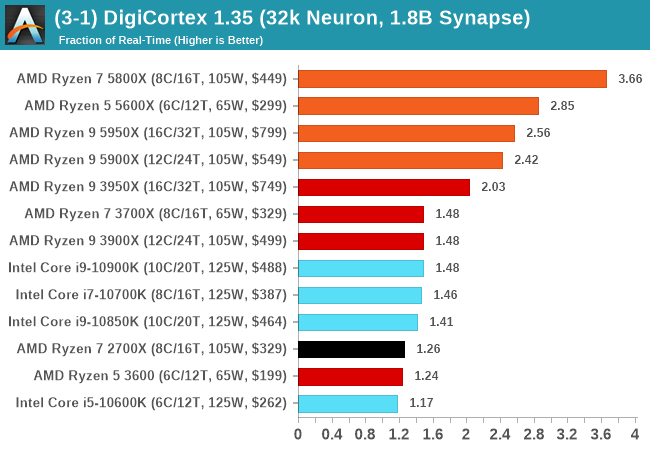
Dwarf Fortress 0.44.12: Link
Another long standing request for our benchmark suite has been Dwarf Fortress, a popular management/roguelike indie video game, first launched in 2006 and still being regularly updated today, aiming for a Steam launch sometime in the future.
Emulating the ASCII interfaces of old, this title is a rather complex beast, which can generate environments subject to millennia of rule, famous faces, peasants, and key historical figures and events. The further you get into the game, depending on the size of the world, the slower it becomes as it has to simulate more famous people, more world events, and the natural way that humanoid creatures take over an environment. Like some kind of virus.
For our test we’re using DFMark. DFMark is a benchmark built by vorsgren on the Bay12Forums that gives two different modes built on DFHack: world generation and embark. These tests can be configured, but range anywhere from 3 minutes to several hours. After analyzing the test, we ended up going for three different world generation sizes:
- Small, a 65x65 world with 250 years, 10 civilizations and 4 megabeasts
- Medium, a 127x127 world with 550 years, 10 civilizations and 4 megabeasts
- Large, a 257x257 world with 550 years, 40 civilizations and 10 megabeasts
DFMark outputs the time to run any given test, so this is what we use for the output. We loop the small test for as many times possible in 10 minutes, the medium test for as many times in 30 minutes, and the large test for as many times in an hour.
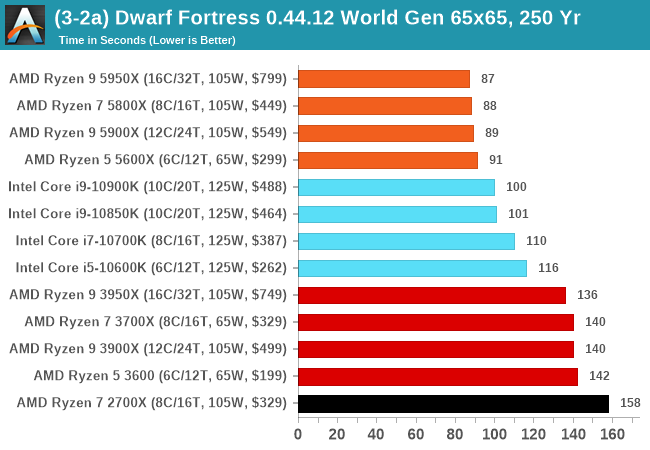
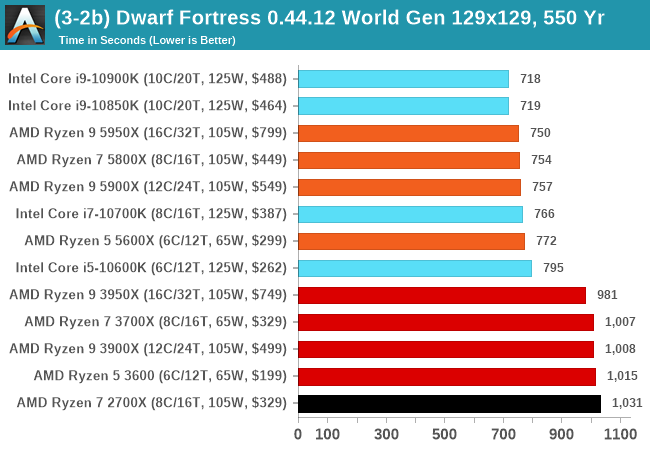
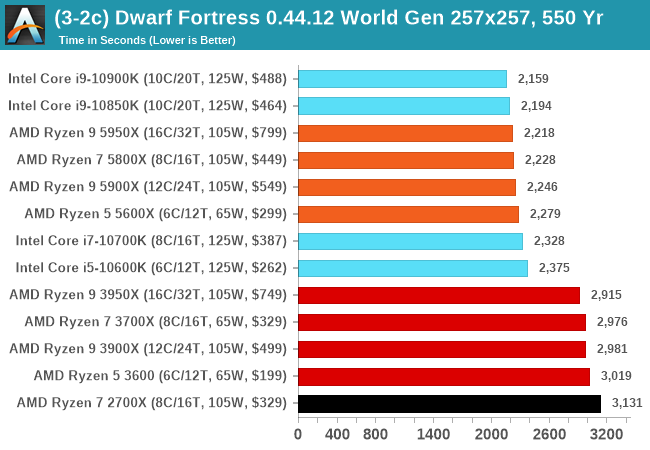
Dolphin v5.0 Emulation: Link
Many emulators are often bound by single thread CPU performance, and general reports tended to suggest that Haswell provided a significant boost to emulator performance. This benchmark runs a Wii program that ray traces a complex 3D scene inside the Dolphin Wii emulator. Performance on this benchmark is a good proxy of the speed of Dolphin CPU emulation, which is an intensive single core task using most aspects of a CPU. Results are given in seconds, where the Wii itself scores 1051 seconds.
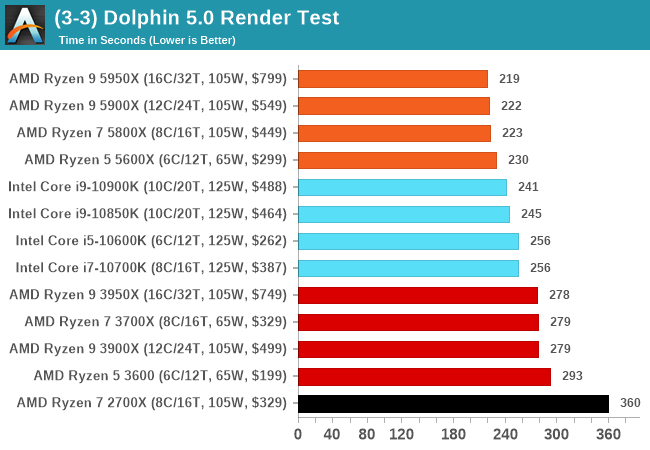












339 Comments
View All Comments
lightningz71 - Friday, November 6, 2020 - link
With the switch to DDR5 coming, there is a need to update the IO die anyway. They could move to a previous node bulk process like TSMC 10nm or Samsung's 8nm and reduce pin count for just three CCDs and manage three CCDs and one IO die in a package well enough. Given that the next CCDs will be on N5P, power draw should come down for those as well, enabling them to stay in the same envelope.lmcd - Monday, November 9, 2020 - link
Samsung's 8nm is provably undesirable for high-volume parts though. I'd argue going the other way, pick a low power node and see if you can get the chiplet architecture in high-end laptop and desktop APU SKUs. That would push their release cadence ahead to same timeframe as desktop and absolutely dominate Intel.eastcoast_pete - Thursday, November 5, 2020 - link
Thanks Ian and Andrei! The one major fly in the ointment for me is the pricing of the entry-level Zen 3 processor. At least one option under $ 200 would have been nice. But then, both AMD and Intel are about making profit for their shareholders, and I guess there isn't a business reason for AMD to offer an entry-level Zen3 below $ 200.owoeweuwu - Thursday, November 5, 2020 - link
why no high resolution + max quality?lame benchmark
Spunjji - Monday, November 9, 2020 - link
Because you won't see any significant difference between the CPUs; It'll just be a bunch of bars next to each other.If that's your use case, then pretty much any of the CPUs in these benchmarks will be enough for you. If you're concerned about how well the CPU you buy now will work with future games then it's a bit of a crap shoot, but these results will give you a better idea than nothing at all.
RedOnlyFan - Thursday, November 5, 2020 - link
So there's not much improvements for gaming. Meh.silverblue - Thursday, November 5, 2020 - link
CS:GO, Shadow of the Tomb Raider, Death Stranding, Serious Sam 4, Hitman 2, Division 2, Flight Simulator 2020 etc. are all showing large gains at 1080p over Zen 2, particularly CS:GO. Check out videos by LTT/Hardware Unboxed (3950 only today)/Gamers Nexus (again, 3950 only today).silverblue - Tuesday, November 10, 2020 - link
Sorry, just realised five days later that I meant to put 5950. Anyway, you all knew what I meant.Spunjji - Sunday, November 8, 2020 - link
It's like you read a different reviewPaazel - Thursday, November 5, 2020 - link
Would be great to see 2600k and a 6700k for reference. These were large benchmark CPU's that lot of people have/had!